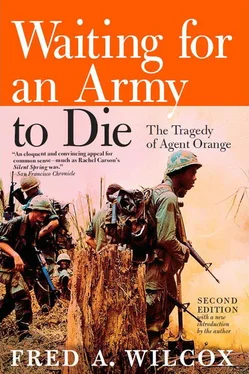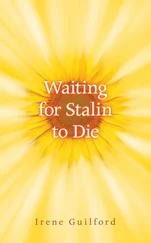7. When You Can’t Sue the Government that Kills You
Victor Yannacone has been called flamboyant, arrogant, a genius, and, I’m sure, many less complimentary things by those whose vested interests he challenges in the name of what he calls the “public good.” Certainly he is not overly modest, calling the Agent Orange class action suit “the most important product liability case in the history of the United States.” Nor is he always gracious or polite, thundering like an evangelist, occasionally answering questions with the clipped irritability of a man who has little time for fools, because he knows only too well that they can be depended on to lose: and Yannacone doesn’t intend to lose when he goes to court on behalf of 2.5 million Vietnam veterans and their families.
He can be charming. He will bring you coffee, buy you lunch and spend the morning, perhaps even part of the afternoon, helping you sort things out, defining legal terms correcting misconceptions, and speaking always with the confidence of a man who, through his successful campaign to remove DDT from the market, has shown that the chemical industry and its multi-million-dollar Washington lobby is not invincible. Yannacone loves a good joke, a humorous story, or a satirical account of court proceedings, but he is not a cynic, and beneath the bravado it is easy to see the intense compassion he feels for the “kids” who served in Vietnam and returned home with what Yannacone calls “an aging disease.”
Victor Yannacone possesses another important attribute. To men who have been lied to, misled, maligned, treated as pariahs, psychopaths, malingerers, hypochondriacs, and disposable war matériel, he just may be the one man in America whom Vietnam veterans feel they can trust.
I am waiting for him to finish a rather long story about how he once defended a man who wanted to keep pigs in his backyard on Long Island. Somehow Yannacone managed to prove that the pigs’ ancestors had provided a valuable service to the community and, he laughs, to convince the judge that the pigs therefore had every right to be where they were. At a nearby desk Carol Yannacone sorts through mail, examines and files autopsy reports on Vietnam veterans and their children. She explains that “many times they don’t really know why the children are born dead or don’t live long after birth. Everything seems to be perfectly normal, but the child dies. So the doctor just files an autopsy report and we get them from lawyers who are working on the class action suit. It is a sad job, sometimes too sad.”
In nearby rooms typewriters clack, computers hum, and Vietnam veterans phone from all over the country seeking advice, asking for help, offering assistance. People enter the office, ask questions, leave notes, and exchange bits of information or gossip with Carol and Victor.
Although he was aware as early as 1969 that defoliants may have resulted in permanent damage to Vietnam mangrove forests, Victor Yannacone’s involvement in the Agent Orange controversy did not really begin until August 1978, when he accepted a luncheon invitation from a group of Long Island attorneys who wished to discuss the Paul Reutershan case. Reutershan, the lawyers told Yannacone, was a young Vietnam veteran who never drank or smoked; he considered himself a “health nut” but was dying of cancer. As a helicopter pilot in Vietnam he had flown through herbicidal mists on numerous occasions, and he believed that his exposure was responsible for his terminal cancer. He had filed a $10 million damage claim against Dow Chemical and two other Agent Orange manufacturers.
Yannacone left the luncheon saddened by what he had heard, but unconvinced that a large number of Vietnam veterans might be suffering from symptoms similar to those that had destroyed Paul Reutershan’s health; however, during the next few months he continued his own research into veterans’ claims that they had been poisoned by Agent Orange. By December 1978 he had learned about Maude DeVictor’s documentation of at least one hundred cases of possible dioxin poisoning; and following Reutershan’s death at age twenty-eight on December 14, 1978, Yannacone began receiving numerous calls from Frank McCarthy, a Vietnam veteran, Paul’s close personal friend and a cofounder of Agent Orange Victims International. Convinced that many of his fellow veterans were suffering from herbicide exposure, McCarthy insisted that Yannacone take legal action against companies that manufactured herbicides for use in Vietnam. On January 8, 1979, having concluded that at least four hundred veterans might have been poisoned by herbicides—but due, in large part, to McCarthy’s persistence—Yannacone filed a class action suit against Dow Chemical et al. on behalf of “all those so unfortunate as to have been and now to be situated at risk, not only during this generation but during generations to come.” The risk was exposure to dioxin, and the lawsuit demanded:
An immediate ban on all advertising, promotion, distribution, marketing and sale of the contaminated herbicides;
A declaration that the corporate defendants are trustees of the public health, safety and welfare, with a fiduciary responsibility to the public.
Disclosure of everything the companies know about the dangers of the contaminated herbicides.
Establishment by the companies of a tax-exempt reserve fund sufficient to cover damages from use of herbicides (reimburse the VA and Social Security Administration for benefits, compensate victims and their families and protect consumers from any attempt to pass along cost of damages resulting from use of utility or railroad rights-of-way). 1
According to the Chicago Tribune (February 1979), the estimated reserve fund would require more than $4 billion.
Soon after Yannacone refilled Reutershan’s initial lawsuit as a class action, Yannacone’s office was deluged with calls from Vietnam veterans and veterans’ widows seeking advice and asking to join the lawsuit. By May 1979 it appeared that at least four thousand claims would be included in the suit, possibly more. According to Yannacone, the question of how the litigation was to be managed became equally as important as the immediate problem of defeating the chemical companies’ various motions to dismiss the complaint. Yannacone was also receiving calls and letters from attorneys throughout the country who wanted to work on the case, and he knew that he had to devise a workable scheme for organizing a task force that would be separated by great geographical distances and, unless the attorneys involved made a very concerted effort to avoid it, the traditional competitiveness of their profession.
“Normally,” explains Yannacone, “in a personal injury case of this magnitude there would be a certain amount of, oh, I wouldn’t say ambulance chasing, that’s not the appropriate expression, but let’s just say jockeying for leadership roles. And because of the size of the litigation that we were envisioning early on—four thousand cases is what we were thinking of—we decided to try something new in the history of personal injury litigation. We would make an agreement with each attorney to divide that case into two parts: liability and damages. We here in New York would handle liability and what we call ‘Cause in Fact’ or Generic Causation . In other words, how toxic is dioxin? And just what can it do? Not what did it do to a particular veteran, but what could it do? Then each individual attorney around the country would handle his own client as a personal injury case as far as proximate cause and damages were concerned, proximate cause meaning: ‘Did this particular veteran manifest the kind of symptoms that would be attributed to dioxin-contaminated herbicides used in Vietnam? And if so, how much damage is he suffering?’ We agreed also to divide whatever fees were awarded by the courts equally, and we agreed from the very beginning—and this is also unique—that we would subject our fee rating to the court for supervision. We then agreed that we would limit out fees, which are contingent of course only on winning, to no more than one-third of recovery, even though some states still allow 50 percent. We also adopted a rule requiring every attorney to file an affidavit saying they didn’t chase the case, they didn’t offer anybody money to get the case, and they violated no disciplinary rules or ethical considerations in acquiring the case. And we have those filed from all of our attorneys. The fact that we’ve filed our agreements and made our financial arrangements known from the beginning is unique in personal injury litigation.”
Читать дальше











